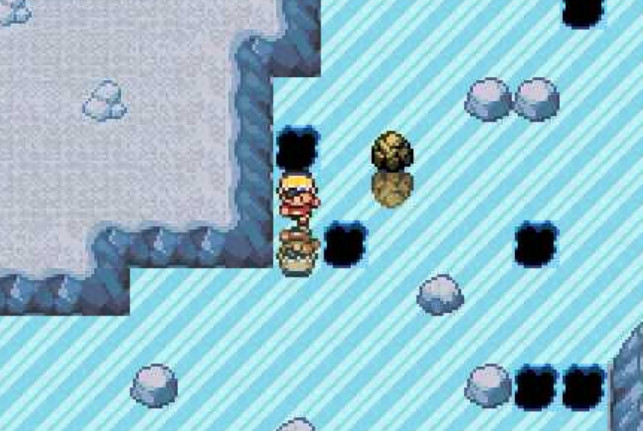Part I is here https://github.com/FeloVilches/Pokemon-Maze
This is a program made in Ruby that solves this kind of puzzle.
There are boulders, walls, holes, and where there's ice the character will slide from one point to another without being able to control its movement.
There's also normal land, where the character can move freely.
Holes make the character fall and of course that'd mean a route that goes through a hole wouldn't be a correct solution.
You'll also find boulders that can be destroyed, but you only have a predefined number of boulders you can break, so breaking every single one of them isn't always the optimal solution.
The route that needs the least moves will be found. Sliding across ice counts as one move.
Use the following command to run every test case. You need the rspec gem first, install it using gem install rspec.
rspec spec/*First two numbers are the starting cell (row, column).
Second line contains two numbers that represent the target cell.
The third line must have a positive number with how many boulders it can break.
After that, there can be any number of lines that represent each row of the map.
0 Ice
1 Wall (or boulder)
2 Normal land
3 Hole
4 Breakable boulder
An input example (it's read from stdin). So if this text is in file.txt you can execute ruby main.rb < file.txt to run the algorithm and solve it.
1 1
11 4
2
1 1 1 1 1 1 1 1 1 1 1 1 1 1 1 1 1
1 2 2 2 2 1 1 1 1 1 1 1 1 1 1 1 1
1 1 1 1 0 1 1 1 1 1 1 1 1 1 1 1 1
1 1 1 1 0 1 1 1 1 1 1 1 1 1 1 1 1
1 1 1 1 0 1 1 1 1 1 1 1 1 1 1 1 1
1 1 1 1 2 2 2 2 2 1 1 1 1 1 1 1 1
1 1 1 1 2 1 1 1 2 1 1 1 1 1 1 1 1
1 1 1 1 4 1 1 1 2 1 1 1 1 1 1 1 1
1 1 1 1 2 1 1 1 4 1 1 1 1 1 1 1 1
1 1 1 1 2 1 1 1 2 1 1 1 1 1 1 1 1
1 1 1 1 4 1 1 1 2 1 1 1 1 1 1 1 1
1 1 1 1 2 2 2 2 2 1 1 1 1 1 1 1 1
1 1 1 1 1 1 1 1 1 1 1 1 1 1 1 1 1
Output will be written to stdout. Example.
→
→
→
↓
↓
↓
↓
↓
↓
↓
If there's no route, it will print no.
